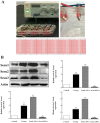Upregulation of sestrins protect atriums against oxidative damage and fibrosis in human and experimental atrial fibrillation
- PMID: 28397812
- PMCID: PMC5387733
- DOI: 10.1038/srep46307
Upregulation of sestrins protect atriums against oxidative damage and fibrosis in human and experimental atrial fibrillation
Abstract
Atrial Fibrillation (AF) is common in the elderly and Sestrins (Sesns) have been suggested to prevent age-related pathologies. The aim of this study was to investigate the effects of Sesns in AF. Clinical data were collected and a small sample of atrial appendage and atrium was obtained from patients undergoing valve repairment. The expression of Sesn1, Sesn2, and Sesn3 was significantly higher in patients with permanent atrial fibrillation (PmAF) than that in sinus rhythm (SR), and further greater in the left atrium than the right in PmAF patients. Superoxide anion and malondialdehyde were enhanced and positively correlated to the protein expression of Sesn1/2/3. Reactive oxygen species (ROS) production and Ca2+ overload were significantly decreased and cell survival was enhanced by overexpression of Sesns 1/2/3 in cultured HL-1 cells. Conversely, knockdown of Sesn1/2/3 resulted in significantly increased ROS and Ca2+ overload. In addition, the overexpression of Sesn1/2 significantly reduced the proliferation of fibroblasts, as well as decreased the protein expression of collagen and fibronectin1 in angiotensin II-stimulated cardiac fibroblasts. Our study demonstrated for the first time that Sesns expression is significantly up-regulated in AF, which therefore may protect hearts against oxidative damage and atrial fibrosis.
Conflict of interest statement
The authors declare no competing financial interests.
Figures








Similar articles
-
Elevated expression of connective tissue growth factor in human atrial fibrillation and angiotensin II-treated cardiomyocytes.Circ J. 2011;75(7):1592-600. doi: 10.1253/circj.cj-10-0892. Epub 2011 May 17. Circ J. 2011. PMID: 21576830
-
TRIF promotes angiotensin II-induced cross-talk between fibroblasts and macrophages in atrial fibrosis.Biochem Biophys Res Commun. 2015 Aug 14;464(1):100-5. doi: 10.1016/j.bbrc.2015.05.131. Epub 2015 Jun 5. Biochem Biophys Res Commun. 2015. PMID: 26056004
-
Angiotensin II activates signal transducers and activators of transcription 3 via Rac1 in the atrial tissue in permanent atrial fibrillation patients with rheumatic heart disease.Cell Biochem Biophys. 2015 Jan;71(1):205-13. doi: 10.1007/s12013-014-0186-z. Cell Biochem Biophys. 2015. PMID: 25151145
-
[Morphological remodeling in atrial fibrillation].Herz. 2006 Apr;31(2):101-7; quiz 142-3. doi: 10.1007/s00059-006-2788-8. Herz. 2006. PMID: 16738831 Review. German.
-
The effects of cardiac stretch on atrial fibroblasts: analysis of the evidence and potential role in atrial fibrillation.Cardiovasc Res. 2022 Jan 29;118(2):440-460. doi: 10.1093/cvr/cvab035. Cardiovasc Res. 2022. PMID: 33576384 Free PMC article. Review.
Cited by
-
Fibronectin 1 inhibits the apoptosis of human trophoblasts by activating the PI3K/Akt signaling pathway.Int J Mol Med. 2020 Nov;46(5):1908-1922. doi: 10.3892/ijmm.2020.4735. Epub 2020 Sep 23. Int J Mol Med. 2020. PMID: 33000176 Free PMC article.
-
OncomiR miR-182-5p Enhances Radiosensitivity by Inhibiting the Radiation-Induced Antioxidant Effect through SESN2 in Head and Neck Cancer.Antioxidants (Basel). 2021 Nov 14;10(11):1808. doi: 10.3390/antiox10111808. Antioxidants (Basel). 2021. PMID: 34829679 Free PMC article.
-
Sestrins in Physiological Stress Responses.Annu Rev Physiol. 2021 Feb 10;83:381-403. doi: 10.1146/annurev-physiol-031620-092317. Epub 2020 Oct 28. Annu Rev Physiol. 2021. PMID: 33113341 Free PMC article. Review.
-
SESTRINs: Emerging Dynamic Stress-Sensors in Metabolic and Environmental Health.Front Cell Dev Biol. 2020 Dec 3;8:603421. doi: 10.3389/fcell.2020.603421. eCollection 2020. Front Cell Dev Biol. 2020. PMID: 33425907 Free PMC article. Review.
-
Sestrin2 as a Protective Shield against Cardiovascular Disease.Int J Mol Sci. 2023 Mar 2;24(5):4880. doi: 10.3390/ijms24054880. Int J Mol Sci. 2023. PMID: 36902310 Free PMC article. Review.
References
-
- Go A. S. et al.. Prevalence of diagnosed atrial fibrillation in adults: national implications for rhythm management and stroke prevention: the Anti-coagulation and Risk Factors in Atrial Fibrillation (ATRIA) Study. JAMA 285, 2370–2375 (2001). - PubMed
Publication types
MeSH terms
Substances
LinkOut - more resources
Full Text Sources
Other Literature Sources
Medical
Research Materials
Miscellaneous

